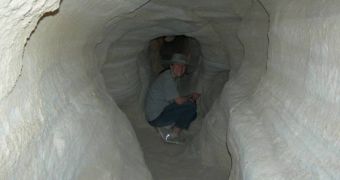When cave tunnels collapse, the faith of the miners trapped behind is often sealed, mostly because emergency rescue teams can rarely reach the pockets where survivors are located in time, before oxygen supplies run out. In addition, drills cannot be performed with electric equipments, as any spark may cause an explosion, on account of the gases that most of the time accumulate inside the collapsed section. Now, researchers at the University of Utah believe they may have discovered a good way of ensuring that miners trapped underground can be saved as soon as possible.
“We developed an approach to find the location of trapped miners inside a collapsed mine, regardless of noise from the environment around the mine,” University of Utah adjunct associate professor of geology and geophysics Sherif Hanafy, who is also the first author of a new paper detailing the technique, published in this month's issue of the Society of Exploration Geophysicists' journal, The Leading Edge, explains about the innovation.
In keeping with the new method, iron plates and sledgehammers will be installed in mine tunnels, at regular intervals. If a cave-in occurs, the survivors should simply hit the iron plate with the sledgehammer, thus generating a distinct noise.
Sophisticated acoustic receptors, placed at strategic locations around the mountains, will pick up and record “seismic fingerprints” generated by a trapped miner banging on the mine wall, and use those fingerprints to locate them. “Each different location in the mine that is banged has a unique fingerprint,” University of Utah professor of geology and geophysics Gerard Schuster, who is also the senior author of the paper, says.
“We hope to make it easier to find out if miners are alive after a collapse and, if they are alive, where they are located. It's not guaranteed to work every time, but looks promising from the tests we did. This is not rocket science; it's rock science,” the scientist also adds. After two tests of the new system, “We got 100 percent accuracy,” Hanafy shares. On one occasion, the method was employed at a copper mine near Tucson, Arizona, while the other test took place beneath the University of Utah campus.
“It's like at a cocktail party you have 2,000 people talking at the same time in different conversations, and somehow you can home in on one conversation,” Schuster explains when talking about the fact that the acoustic receptors can pick up signals that come from very close areas. “We had 25 base stations inside the tunnel, and we calculated the result for each one assuming a trapped miner was at each one of these. We were able to locate exactly where each bang was coming from,” though the iron plates were as less as 1.6 feet apart, Hanafy concludes.

 14 DAY TRIAL //
14 DAY TRIAL //